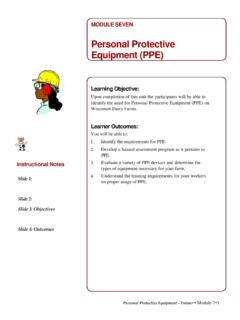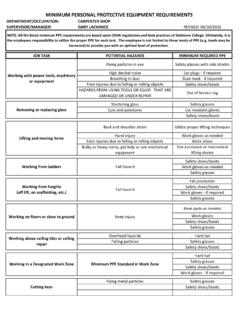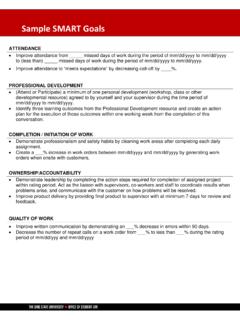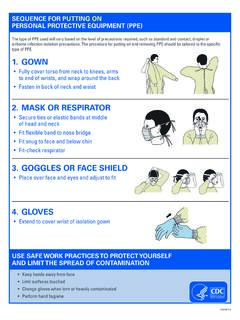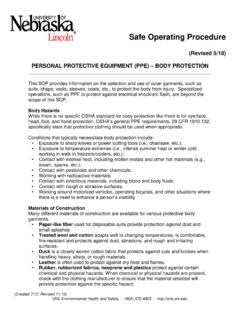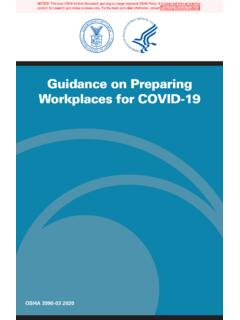Transcription of Appendix 5 – Properties of PPE for use in healthcare
1 Interim infection prevention and control guidelines for the management of COVID-19 in healthcare settings - Version 4 October 2020 Page 52 Appendix 5 Properties of PPE for use in healthcare The hierarchy of control is a system for controlling risks in the workplace. The Australian Guidelines for the Prevention and Control of Infection in healthcare (2019), available at , has an overview of risk management in infection prevention and control. The use of PPE is the lowest in the hierarchy of control measures and is also considered the least reliable. All other measures should be taken to remove or control the risk to workers and patients where it is practicable to do so without the need for PPE.
2 healthcare workers must perform a local risk assessment prior to fitting PPE to inform their use and selection of PPE. This risk assessment should consider the type of patient interaction, the risk of transmission of the infectious agent, and the risk of contamination of the healthcare worker skin/mucous membranes by patients blood, body substances, secretions or excretions and how long the PPE is likely to be required to be worn. Any examples included in this Appendix are not exhaustive and are intended to illustrate potential uses for each type of protection. The Therapeutic Goods Administration (TGA) provides advice for alternative use of PPE when supply levels reach crisis supply levels.
3 This information can be found at Items of PPE that are labelled or promoted for use in surgical or hospital environments require inclusion in the Australian Register of Therapeutic Goods (ARTG). Standards Australia have published the relevant Australian or joint Australian/New Zealand standards that PPE must meet, including the applicable conformance test methods. This information is available at Masks Surgical masks Surgical masks are single use, fluid-resistant, disposable and loose fitting protection devices that create a physical barrier between the mouth and nose of the wearer and the immediate environment but do not achieve a close seal to the wearer's face.
4 When used, surgical masks should cover both the mouth and the nose and be secured using the ear loops or ties at the back of the head. Surgical masks are graded as barrier level 1, 2 or 3 based on the level of protection provided and fluid resistance and are used for blocking splashes and large particle droplets or sprays which may occur (see below). They do not provide complete protection from pathogens and other small particle contaminants. Australian Standard 4381:2015 Single use face masks for use in health care (AS 4381:2015) sets out the requirements for single use face masks which are used in healthcare .
5 Masks intended by the manufacturer for use in an Australian hospital setting to reduce the transmission of pathogens should be included on the Australian Register of Therapeutic Goods (ARTG). These masks are used to minimise mucous membrane exposure to infectious microbial droplets. Under review Interim infection prevention and control guidelines for the management of COVID-19 in healthcare settings - Version 4 October 2020 Page 53 Surgical masks are suitable for droplet precautions and are not suitable for use to protect the wearer from airborne infectious agents. Please see the section for respirators (P2/95 respirators) below for more information about respirators that are suitable for airborne precautions.
6 Face masks are categorised as level 1 barrier, level 2 barrier or level 3 barrier. The barrier protection levels refer to the characteristics of the masks based on three characteristics (see Table 1). The masks resistance to penetration by synthetic blood at different pressures is the characteristic that is most relevant when considering whether a level 1, 2 or 3 barrier masks is used. The COVID-19 pandemic has led to worldwide shortages of level 3 barrier protection masks. All three levels of surgical masks are fluid-resistant; however, the level of fluid resistance increases with each level of mask.
7 Please refer to the Australian Standard 4381:2015 Single use face masks for use in health care for detailed information. In the majority of situations where standard respiratory protection is needed, a single use surgical mask is appropriate (minimum level 1 barrier). Considerations when using a surgical mask include: Masks should be changed when they become soiled or wet. Masks should never be reapplied after they have been removed. Masks should not be left dangling around the neck. Touching/adjusting the front of the mask while wearing it should be avoided. Hand hygiene should be performed upon touching or discarding a used mask.
8 Under reviewInterim infection prevention and control guidelines for the management of COVID-19 in healthcare settings - Version 4 October 2020 Table 1. Characteristics of level 1, level 2, and level 3 surgical masks. Information adapted from AS 4381:2015 Characteristics Level 1 Level 2 Level 3 Bacterial filtration efficiency % 95 98 98 Differential pressure (mm H2O/cm2) < < < Resistance to penetration by synthetic blood (minimum pressure in mm Hg for pass) 80 mm Hg 120 mm Hg 160 mm Hg Standard precautions Yes Yes Yes Droplet precautions Yes Yes Yes Suitable uses (as per AS 4381:2015) For general purpose medical procedures where the wearer is not at risk of blood or body fluid splash or to protect staff and/or the patient from droplet exposure to microorganisms.
9 For use in emergency departments, dentistry, changing dressings on small wounds or healing wounds where minimal blood droplet exposure may possibly occur. For all surgical procedures, major trauma first aid or in any area where the health care worker is at risk of blood or body fluid splash. Examples of use When the likelihood of exposure to body fluid is low, in routine care of suspected, probable, confirmed cases of COVID-19: suitable for the collection of nasopharyngeal swabs, interventions such as a patient interview, physiotherapy, nursing observations, administering most medications, assisting with most ADLs or encounters at a reception counter.
10 Suitable to be provided to symptomatic patients or carer/s of those with respiratory symptoms. If only a level 1 mask is available and splash or spray of body fluid is anticipated, the level 1 mask may be used in combination with a full-face shield. Use when there is a risk of blood or body fluid exposure/splash. Procedures where moderate to low blood or body fluid splash or spray or droplets are possible such as endoscopic procedures, IVC insertion, IDC emptying or phlebotomy. These should be reserved for operating theatre use and trauma use where able. All interventions or situations where a blood or body fluid splash is more likely to occur such as during surgical procedures or obtaining an arterial blood specimen or there is or are likely to be large volumes of bodily fluids present.










